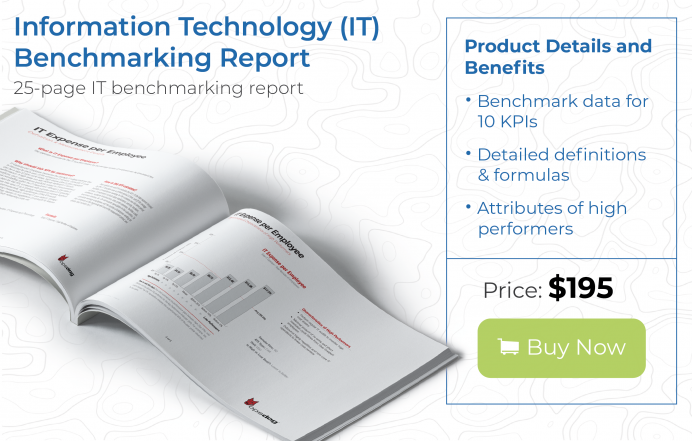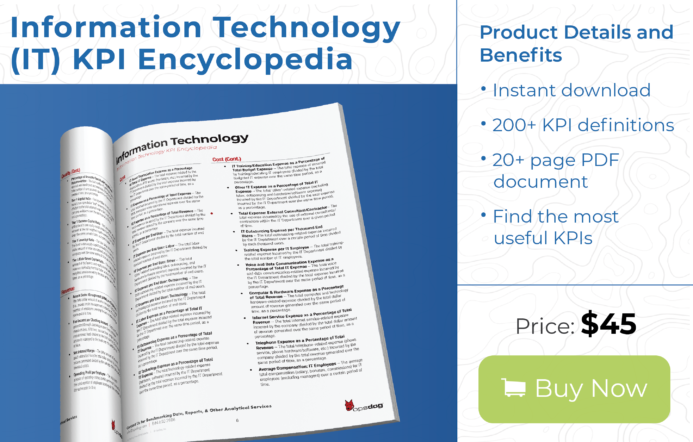I’m sure you are well aware how important and useful information technology (IT) departments are in a world where technology dominates nearly every industry from banking to logistics. Starting a new job and need the computer system up and running? Not a problem. Working through an important financial document when the next ice age blows through, leaving you frustrated over an immovable screen that mocks your every futile move? Not a problem. Is your security system ignoring you while cyber space shattering viruses are invading your computer? Not a problem. The IT Department can solve all these issues and more, making your internal systems run smoothly while protecting all the company’s sensitive information.
So how can IT companies or departments keep up with the demand for expert level service, especially when most of the people asking for help are at their wits end over what they should do next? As a first step, identify, measure and benchmark IT support metrics within your business intelligence efforts. Tracking the data associated with these IT Key Performance Indicators in your benchmarking and business intelligence efforts will not only show the company or department what is actually happening in terms of IT support operations, but it will also show what can be improved to boost the IT Department’s productivity and efficiency.
What are IT Support metrics?
IT Support Key Performance Indicators are defined as the quantitative values used to determine how efficiently and effectively specific IT support goals and objectives are achieved by the company’s Information Technology (IT) Department over a set period of time.
Benefits of measuring and benchmarking KPIs for technical support in your company business intelligence efforts include:
- Improved customer experience
- Improved productivity and performance management of IT employees
- Reduced operational cost of the IT Department
- Increased company network availability and uptime
Let’s take a look at a few Key Performance Indicator examples for the Information Technology (IT) support function that you should add to your benchmarking and business intelligence efforts.
IT Key Performance Indicator Example # 1: Cycle Time: Customer Support Ticket Resolution
Use the Cycle Time: Customer Support Ticket Resolution KPI for the IT Department to measure the number of hours required to resolve a customer support, or help ticket. The clock starts running from the time the help ticket is opened and stops when the customer issue is resolved. A customer support ticket is a mechanism used to track the detection, reporting and resolution of an IT problem encountered by the company’s employees, also known as end-users.
High values for this IT KPI example can be indicative of:
- Inefficient call scripts and job help guides
- Sub-par collection of information pertaining to the customer’s issue
- Poor IT employee productivity and performance management practices
- Insufficient IT employee training
To keep the value low for this IT support metric , IT managers should improve their performance management practices to identify the specific issue(s) causing prolonged customer support ticket resolution times. For instance, if the process pertaining to customer issue information collection is the problem, standardizing the processes and formats for customer support ticket submissions will reduce the number of times IT employees have to contact the customer to figure out what the problem is because some crucial detail was left out of the submission form, thus reducing the overall amount of time needed to solve the issue. Standardized submission forms can also prevent the IT employee from exploring solution activities that have already been attempted.
IT Key Performance Indicator Example # 2: Mean Time to Repair (MTTR)
Use the Mean Time to Repair (MTTR) KPI for the IT Department to measure the average number of hours required to repair the system, application or network to full functionality following a failure, or service interruption. Measurement begins at the time the failure occurs and ends when the repair is completed and rolled out to all required locations, including servers, devices, workstations, etc.
High values for this IT KPI example can indicate:
- Poor IT employee training
- Inadequate IT productivity and performance management practices
- Inefficient issue response procedures
- Systems not built to facilitate speedy debugging and recovery
To keep values low for this IT Key Performance Indicator, seek to standardize issue response procedures, periodically train IT employees to allow them to keep up-to-date on current issue resolution practices and improve the training programs themselves to ensure IT employees know how to resolve all relevant issues. High values for this Key Performance Indicator example for Information Technology can have a dire effect on the company’s business operations, such as accessing important company data or customer records, which can harm the company’s ability to satisfy their customer’s needs.
IT Key Performance Indicator Example # 3: Mean Time Between Failures (MTBF)
Use the Mean Time Between Failures (MTBF) KPI for the IT Department to measure the average number of days elapsed between network, system, or application failures or outages. The moment the network, system, or application initially fails is considered to be the first measured date while the day the next failure occurs is considered to be the last measured date. Mean Time Between Failures (MTBF) includes the time required to perform any repairs after the initial failure.
For this KPI for IT managers, the longer the time period between failures, the better. If a system is failing every week, company employees will not be able to efficiently get their work completed. Be aware that the value for Mean Time Between Failures (MTBF) includes only operational time, not repair or outage time. Don’t worry though, those are separate metrics. To reduce the Mean Time Between Failures (MTBF) value, attempt to segment the time between failures with the use of different systems and software packages. This allows IT managers and employees to identify the specific network, system or application that is causing the issue.
Low values for this IT KPI example can be indicative of:
- Poorly developed networks, systems or applications
- Sub-par IT employee repairs
- Inefficient testing of the network, system or application before releases
IT Key Performance Indicator Example # 4: Support Tickets Closed per Employee
Use the Support Tickets Closed per Employee KPI for the IT Department to measure the division between the number of customer support tickets resolved, or closed and the total number of employees processing and resolving customer support tickets.
Similar to Cycle Time: Customer Support Resolution, low values for this IT KPI example can indicate:
- Poor IT employee productivity and performance management practices
- Inefficient or inadequate IT employee training
- Non-standardized call scripts
- Inadequate use of job help guides, FAQs and other helpful IT resources
As you might expect, it’s not a good thing to receive lots of calls concerning IT issues since that means there are a lot of problems that need to be resolved, but when it comes to productivity, the higher the value for this IT support metric, the better. Improving the values for this KPI for IT managers not only ensures that employees are provided with targeted training, but also provides managers with insights into what part of the process is causing a productivity bottleneck. It is important to note that less productivity can prolong the period of time necessary to resolve all incoming issues, thus negatively impacting the ability of the effected employees from performing their own duties.
IT Key Performance Indicator # 5: Unit Cost: Customer Support Ticket
The Unit Cost: Customer Support Ticket KPI for the IT Department measures the total expense incurred by the User Support & Services compared to the total number of customer support tickets opened over the same period of time. Though a bit different than the previous IT support metrics, defining the cost of operations is a must. This Key Performance Indicator Example for Information Technology, in consequence, keeps track of just how much money is being spent to bring computer support to each employee experiencing technical issues.
High values for this IT KPI example can be indicative of:
- Inefficient or inadequate IT employee training
- Sub-par IT employee productivity and performance management practices
- Poor dissemination of IT information on end-user-focused FAQ and IT resource channels
To keep values low for this IT Key Performance Indicator, look to improve performance management practices and keep customer, or end-user-facing FAQs and other self-service tools up-to-date on what end-users can do to fix IT issues themselves. After all, if customers are able to fix their own IT issues, fewer end-users will call IT employees for assistance which will reduce the overall amount of money the IT Department spends by having their IT employee fix end-user issues. This, furthermore, allows IT employees to focus on other important tasks, thus improving their productivity in other IT-related areas.
IT Key Performance Indicator Final Thoughts and Resources
Thanks for sticking with me thus far. Tracking IT support metrics and benchmarks should be on the top of IT manager’s to do list. For those within the information technology businesses, doing so will not only bring a higher quality of service to their customers, but it will also make sure they can stay in the business of providing technological services. Heck, using IT Key Performance Indicators, metrics and benchmarks to improve IT Department operations will even help in outperforming competitors and improve the company’s bottom line. Now, who wouldn’t like that?



